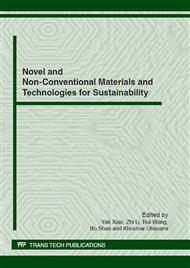p.864
p.870
p.875
p.881
p.887
p.892
p.897
p.904
p.910
Research of Thermal and Moisture Transport within Compound Bamboo Wall with Different Moisture Content
Abstract:
In order to evaluate the energy-saving effect of the bamboo plywood as building enclosure, by measuring thermal conductivity of compound bamboo building enclosure with different moisture content, performance function between bamboo characteristic and thermal conductivity were deduced with numerical analysis method. First, we measured thermal conductivity with different moisture content. For the accuracy of data, we put a thin plastic film between the heating layer of the tester and the bamboo plywood to reduce water evaporation. Then we got the functional relation of moisture content and thermal conductivity, by using numerical analysis software. Finally, according to the national related standard and the performance of the bamboo plywood within different moisture content, we analyzed the advantages and disadvantages of the bamboo plywood as building enclosure. The results showed that the heat preservation and thermal insulation properties of bamboo plywood as construction materials are both stronger than traditional building materials such as reinforced concrete with different moisture content. Meanwhile, so as to ensure the heat preservation and thermal insulation properties and to achieve a good energy saving effect, wed better keep the moisture content of bamboo plywood in a low state.
Info:
Periodical:
Pages:
887-891
Citation:
Online since:
June 2012
Authors:
Price:
Сopyright:
© 2012 Trans Tech Publications Ltd. All Rights Reserved
Share:
Citation:


